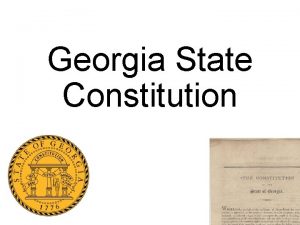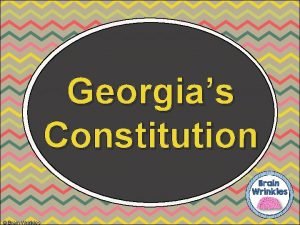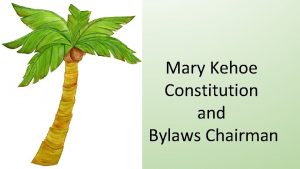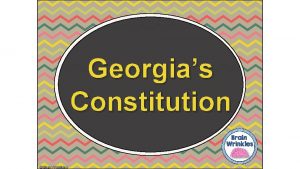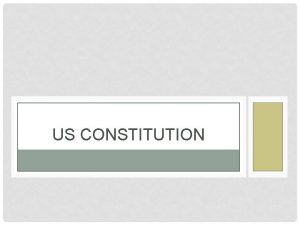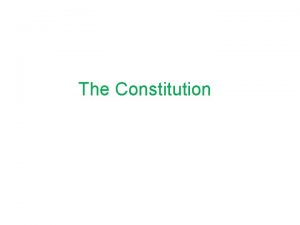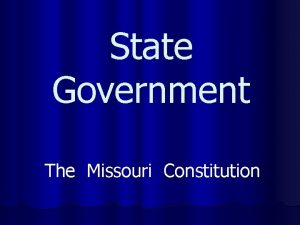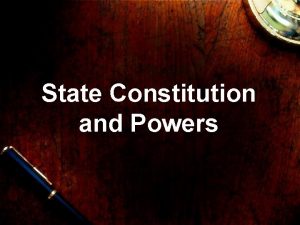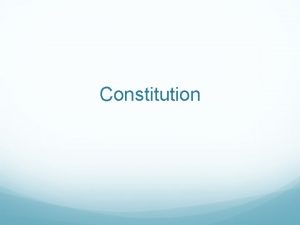The Constitution Chapter 3 State Constitution In January













- Slides: 13

The Constitution Chapter 3

State Constitution In January 1776, New Hampshire became the first colony to organize as a state. The leaders wrote a constitution: a detailed written plan for the government. Soon all of the colony had a state constitution. Each state had a legislature to make laws. Most of the legislatures were bicameral. This means they were divided into two parts, or houses.

A confederation is a group of individual state governments that unite for a common purpose. The Articles of Confederation In 1777 the congress wrote out these plans in the Articles of Confederation. This document became the first constitution of the United States government. The Articles of Confederation set up a “league of friendship” among independent states. By 1781 all 13 states had ratified or approved, the Articles. The Articles of Confederation created a one-house legislature in which each state had one vote.

Shay’s Rebellion The Articles of Confederation were too weak to deal with many of the problems facing the new country. This created Shay Rebellion.

Creating a New Constitution Chapter 3

In the spring of 1787, delegates met in Philadelphia to fix the Articles of Confederation. The Constitutional Convention The delegates chose George Washington to guide the convention. The delegates made a key decision that all states would have one vote. The delegates kept the work of the convention secret. The public was not allowed in the meetings.

The delegates only job was to revise the Articles of Confederation. The Constitutional Convention They decided that the current government was too weak to deal with national problems, therefore they agreed to begin anew. They need a entirely new plan of government- a new constitution. The meeting in Philadelphia came to be known as the Constitutional Convention.

James Madison had written a plan for strong national government. It was know as the Virginia Plan. The Virginia Plan had federal government. It consisted of a president, courts, and congress with two houses. Compromising for a Constitution Larger states would have more votes than smaller states. Delegates from Massachusetts, Pennsylvania, and Virginia like the plan because they had several people in their state.

William Patterson of New Jersey offered the New Jersey Plan. It was based on the Articles of Confederation, with some changes. Compromising for a Constitution The plan kept the Confederation’s one-house congress. Each state would have one vote. Congress could set taxes and regulate, or control, trade. This plan did not have a strong president but a less powerful committee to named by Congress to carry out laws. Delegates from smaller states backed this plan. In the New Jersey Plan smaller had the same power as larger states.

Compromising for a Constitution Roger Sherman of Connecticut found an answer. The committee decided that Congress would have two houses, a Senate and a House of Representative. In the Senate each state would have two members. In the House the number of seats for each state would reflect that state’s population. Historians call Sherman’s plan the Connecticut Compromise, or the Great Compromise.

A compromise is an agreement between two or more sides. Compromising for a Constitution In 1787, more than 550, 000 African Americans were enslaved. Most of these slaves lived in southern states, so those states hope to count their slaves. The northern states did not agree with this. The delegates worked out an agreement called the Three. Fifths Compromise. This Compromise states that every five enslaved person would be equal three free persons.

Federalists and Anti. Federalists are people who supported the Constitution. They believe the Constitution would create a system of federalism, that is, a form of government in which divided between the federal, or national government and the states. The main leaders of the Federalist were Alexander Hamilton, James Madison, and John Jay. To defend the Constitution, they wrote essays called the Federalist Papers.

Federalists and Anti. Federalists The Anti-Federalists opposed the Constitution. They argued that the new Constitution would destroy the liberties that won by the American Revolution. The Anti-Federalist saw a key weakness in the new Constitution. It did not have a bill of rights. Several states declared that they would not ratify the Constitution without the bill of rights.
 Texas constitution vs u.s. constitution venn diagram
Texas constitution vs u.s. constitution venn diagram Nc constitution vs us constitution
Nc constitution vs us constitution Constitution what is constitution
Constitution what is constitution Lesson 1 principles of the constitution
Lesson 1 principles of the constitution Hình ảnh bộ gõ cơ thể búng tay
Hình ảnh bộ gõ cơ thể búng tay Frameset trong html5
Frameset trong html5 Bổ thể
Bổ thể Tỉ lệ cơ thể trẻ em
Tỉ lệ cơ thể trẻ em Voi kéo gỗ như thế nào
Voi kéo gỗ như thế nào Tư thế worms-breton
Tư thế worms-breton Chúa sống lại
Chúa sống lại Các môn thể thao bắt đầu bằng tiếng đua
Các môn thể thao bắt đầu bằng tiếng đua Thế nào là hệ số cao nhất
Thế nào là hệ số cao nhất Các châu lục và đại dương trên thế giới
Các châu lục và đại dương trên thế giới














